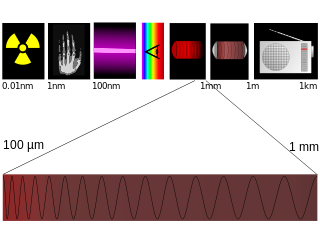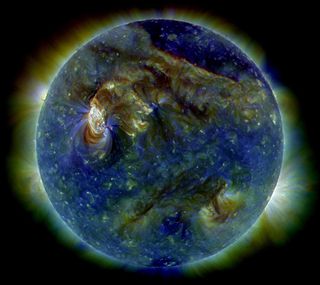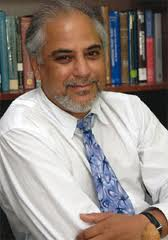
A laser is a device that emits light through a process of optical amplification based on the stimulated emission of electromagnetic radiation. The term "laser" originated as an acronym for "Light Amplification by Stimulated Emission of Radiation". The first laser was built in 1960 by Theodore H. Maiman at Hughes Research Laboratories, based on theoretical work by Charles Hard Townes and Arthur Leonard Schawlow.

The Deutsches Elektronen-Synchrotron commonly referred to by the abbreviation DESY, is a national research center in Germany that operates particle accelerators used to investigate the structure of matter. It conducts a broad spectrum of inter-disciplinary scientific research in three main areas: particle and high energy physics; photon science; and the development, construction and operation of particle accelerators. Its name refers to its first project, an electron synchrotron. DESY is publicly financed by the Federal Republic of Germany, the States of Germany, and the German Research Foundation (DFG). DESY is a member of the Helmholtz Association and operates at sites in Hamburg and Zeuthen.

SLAC National Accelerator Laboratory, originally named Stanford Linear Accelerator Center, is a United States Department of Energy National Laboratory operated by Stanford University under the programmatic direction of the U.S. Department of Energy Office of Science and located in Menlo Park, California.

Terahertz radiation – also known as submillimeter radiation, terahertz waves, tremendously high frequency (THF), T-rays, T-waves, T-light, T-lux or THz – consists of electromagnetic waves within the ITU-designated band of frequencies from 0.3 to 3 terahertz (THz). One terahertz is 1012 Hz or 1000 GHz. Wavelengths of radiation in the terahertz band correspondingly range from 1 mm to 0.1 mm (or 100 μm). Because terahertz radiation begins at a wavelength of one millimeter and proceeds into shorter wavelengths, it is sometimes known as the submillimeter band, and its radiation as submillimeter waves, especially in astronomy.

Diamond Light Source is the UK's national synchrotron science facility located at the Harwell Science and Innovation Campus in Oxfordshire. Its purpose is to produce intense beams of light whose special characteristics are useful in many areas of scientific research. In particular it can be used to investigate the structure and properties of a wide range of materials from proteins, and engineering components to conservation of archeological artifacts.

A free-electron laser (FEL) is a kind of laser whose lasing medium consists of very-high-speed electrons moving freely through a magnetic structure, hence the term free electron. The free-electron laser is tunable and has the widest frequency range of any laser type, currently ranging in wavelength from microwaves, through terahertz radiation and infrared, to the visible spectrum, ultraviolet, and X-ray.
The Rutherford Appleton Laboratory (RAL) is one of the national scientific research laboratories in the UK operated by the Science and Technology Facilities Council (STFC). It began as the Rutherford High Energy Laboratory, merged with the Atlas Computer Laboratory in 1975 to create the Rutherford Lab; then in 1979 with the Appleton Laboratory to form the current laboratory.

Photodetectors, also called photosensors, are sensors of light or other electromagnetic radiation. A photo detector has a p–n junction that converts light photons into current. The absorbed photons make electron–hole pairs in the depletion region. Photodiodes and photo transistors are a few examples of photo detectors. Solar cells convert some of the light energy absorbed into electrical energy.

Extreme ultraviolet radiation or high-energy ultraviolet radiation is electromagnetic radiation in the part of the electromagnetic spectrum spanning wavelengths from 124 nm down to 10 nm, and therefore having photons with energies from 10 eV up to 124 eV. EUV is naturally generated by the solar corona and artificially by plasma and synchrotron light sources. Since UVC extends to 100 nm, there is some overlap in the terms.
Self-amplified spontaneous emission (SASE) is a process within a free-electron laser (FEL) by which a laser beam is created from a high-energy electron beam.
Elettra Sincrotrone Trieste is an international research center located in Basovizza on the outskirts of Trieste, Italy.
Accelerators and Lasers In Combined Experiments (ALICE), or Energy Recovery Linac Prototype (ERLP) is a 35MeV energy recovery linac test facility at Daresbury Laboratory in Cheshire, England. The project was originally conceived as a test bed for 4GLS, and consists of:

The Synchrotron Radiation Source (SRS) at the Daresbury Laboratory in Cheshire, England was the first second-generation synchrotron radiation source to produce X-rays. The research facility provided synchrotron radiation to a large number of experimental stations and had an operating cost of approximately £20 million per annum.

Swapan Chattopadhyay is a particle accelerator physicist noted for his pioneering contributions of innovative concepts, techniques and developments in high energy particle colliders, coherent and incoherent light sources, ultrafast sciences in the femto- and atto- second regimes, superconducting linear accelerators and various applications of interaction of particle and light beams. He has directly contributed to the development of many accelerators around the world, e.g. the Super Proton-Antiproton Synchrotron at CERN, the Advanced Light Source at Berkeley, the asymmetric-energy electron-positron collider PEP-II at Stanford, the Continuous Electron Beam Accelerator facility (CEBAF) at Jefferson Lab and the Free-Electron Lasers at Jefferson and Daresbury Laboratories.

MAX IV is the next-generation synchrotron radiation facility in Lund, Sweden. It is the strongest of its kind in the world. Its design and planning has been carried out within the Swedish national laboratory, MAX-lab, which up until 2015 operated three accelerators for synchrotron radiation research: MAX I, MAX II and MAX III. MAX-lab supported about 1000 users from over 30 countries annually. The facility operated 14 beamlines with a total of 19 independent experimental stations, supporting a wide range of experimental techniques such as macromolecular crystallography, electron spectroscopy, nanolithography and production of tagged photons for photo-nuclear experiments. The facility closed on the 13th of December 2015 in preparation for MAX IV.

The Berliner Elektronenspeicherring-Gesellschaft für Synchrotronstrahlung m. b. H., abbreviated BESSY, is a research establishment in the Adlershof district of Berlin. Founded on 5 March 1979, it currently operates one of Germany's 3rd generation synchrotron radiation facilities, BESSY II. Originally part of the Leibniz Association, BESSY now belongs to the Helmholtz-Zentrum Berlin.
Laser-based angle-resolved photoemission spectroscopy is a form of angle-resolved photoemission spectroscopy that uses a laser as the light source. Photoemission spectroscopy is a powerful and sensitive experimental technique to study surface physics. It is based on the photoelectric effect originally observed by Heinrich Hertz in 1887 and later explained by Albert Einstein in 1905 that when a material is shone by light, the electrons can absorb photons and escape from the material with the kinetic energy: , where is the incident photon energy, the work function of the material. Since the kinetic energy of ejected electrons are highly associated with the internal electronic structure, by analyzing the photoelectron spectroscopy one can realize the fundamental physical and chemical properties of the material, such as the type and arrangement of local bonding, electronic structure and chemical composition.
An energy recovery linac (ERL) provides a beam of electrons used to produce x-rays by synchrotron radiation. First proposed in 1965 the idea gained interest since the early 2000s.
Terahertz gap is an engineering term for a frequency band in the terahertz region of the electromagnetic spectrum between radio waves and infrared light for which practical technologies for generating and detecting the radiation do not exist. It is defined as 0.1 to 10 THz. Currently, at frequencies within this range, useful power generation and receiver technologies are inefficient and impractical.














